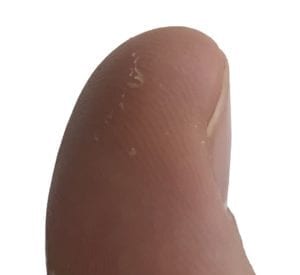Kit Green Sanderson
Canada
 |
| A thumb exhibiting a positive “Sanderson’s Thumb” sign. Photo by the author. |
If you are in the medical profession, you have likely heard of the Babinski reflex or McBurney’s point, but have you ever heard of Sanderson’s thumb? No? Let me explain . . .
Sleep deprived, overworked, and two hours away from the end of your 24-hour shift in the emergency room, a patient comes to you, acutely unwell. Despite examining the patient thoroughly from head to toe, you have no differential diagnosis until an exhaustive biochemical workup finally indicates acute vitamin B6 toxicity.
What could a patient have consumed to get to this point? After some research on Google and conferring with the patient, they admit to an excessive indulgence of pistachios. How could you have missed this? If medical school has taught you anything, it is that patients will often underestimate or hide, their alcohol, tobacco, and pistachio abuse.
While any patient can lie, they are often betrayed by the tell-tale signs. Alcoholics cannot hide hepatomegaly and deranged liver function tests, while tar stained fingers and a chronic cough will always give the smoker away. What about pistachio abusers? Do they get off scot-free? Not anymore! Introducing “Sanderson’s Thumb”: a small calloused lesion on the inferolateral aspect of the dominant thumb, exclusive to pistachio consumers (Figure 1). Simply asking the patient about pistachio abuse may prove to be beneficial, however, you cannot put your name on that.
Hopefully it is clear that pistachio abuse is not a pressing medical concern. However, the facetiously named “Sanderson’s Thumb” was fabricated in order to draw attention to another issue: medical eponyms, the practice of making a medical discovery and stamping your name on it. Medicine is brimming with eponymously named conditions, signs, and procedures. While some doctors argue that eponyms make medical terminology easier to remember, there are a multiplicity of inherent pitfalls to this practice.
Medical research is a cumulative effort, often requiring large teams both at, and in between, research facilities. The use of medical eponyms excludes members who participated in the work leading up to the discovery. The use of hyphenated eponyms may potentially solve this problem, however it inevitably creates new complications. For example, Mayer–Rokitansky–Küster–Hauser syndrome does not exactly roll off the tongue, and medical students dread memorizing long medical eponyms such as this.
The ideal medical terminology is a name that is both memorable and self-descriptive. For example, Mayer–Rokitansky–Küster–Hauser syndrome is also known as Müllerian agenesis. In order to understand this nomenclature, a little background is needed.
- Much of the female genital tract is embryologically derived from a structure called the Müllerian duct.
- Agenesis means a lack of genesis, or a lack of development.
The name Müllerian agenesis actually tells us a lot about the disease. On the other hand, Mayer–Rokitansky–Küster–Hauser syndrome is clunky, hard to memorize, and tells us nothing about the disease.
While many eponyms are generally unique, some researchers have multiple eponyms named after themselves. For example, a diagnosis of “De Quervain’s” could mean you have De Quervain’s tenosynovitis or De Quervain’s thyroiditis, two completely unrelated disorders. To further muddy the waters, in order to confirm a diagnosis of De Quervain’s tenosynovitis, you must perform the modified Eichoff maneuver, commonly called Finkelstein’s test. If this was not confusing enough, there are often many independently named eponymous signs that are associated with a single disorder. For example, Ashrafian attempted to list all of the eponyms associated with aortic regurgitation and was able to amass a total of thirty-one associated eponymous terms (Ashrafian 2006).
A further consequence of historical eponyms can be seen in the unfortunate scenario of many medical advances originating from 1940’s Germany. This has left many common medical terms crediting their Nazi authors posthumously. For example, a disease once known as “Wegener’s Granulomatosis” is now often referred to as the long winded “Granulomatosis with Polyangiitis (formerly known as Wegener’s).”
Medical eponyms, such as the aforementioned, facetiously named “Sanderson’s Thumb,” should be abolished. The proposed solution to this matter is to implement Sanderson’s Law, which states: from this day forth, no more eponymous medical terms should be coined.
References
- Ashrafian, H. 2006. “Pulsatile pseudo-proptosis, aortic regurgitation and 31 eponyms.” Int J Cardiol 107 (3):421-3. doi: 10.1016/j.ijcard.2005.01.060.
KIT GREEN SANDERSON is a medical student finishing his third year at the at the Royal College of Surgeons in Ireland. He looks for humour in medicine and enjoys sharing it with others.
Winter 2020 | Sections | Personal Narratives

Leave a Reply